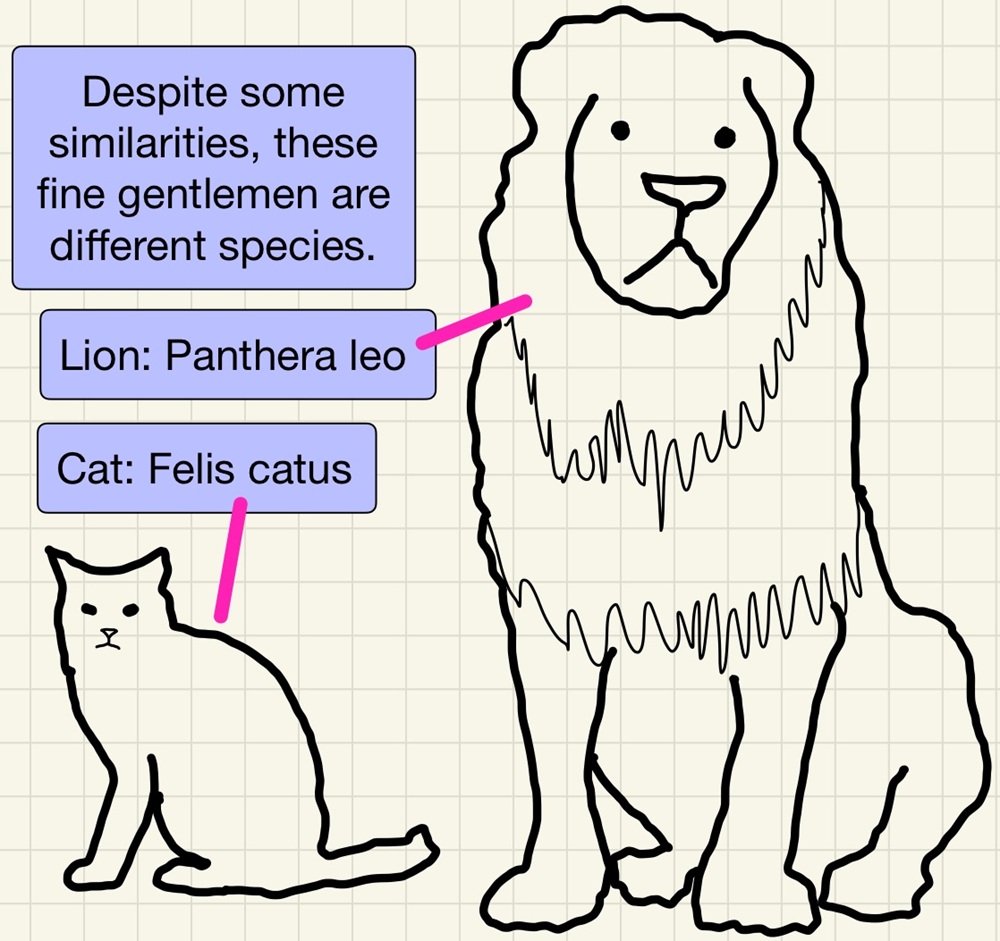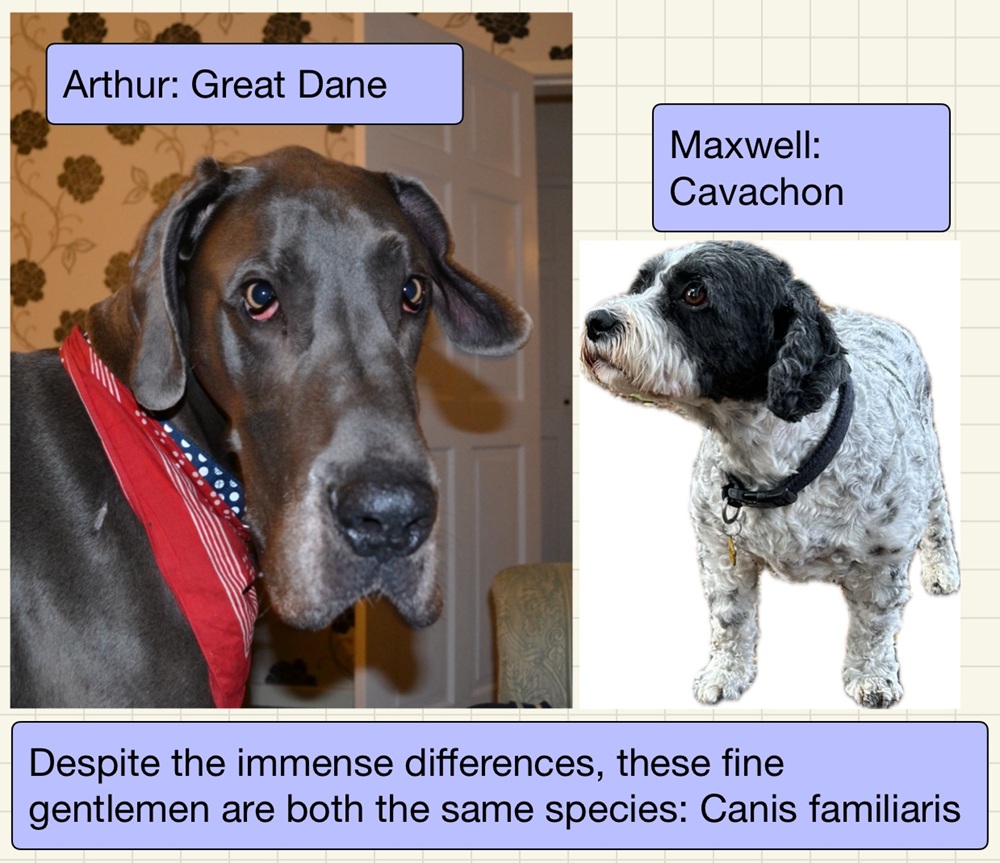Key Stage 3 Inheritance
What we are learning:
What is a species?

Here we look at what a species is and come up with a definition. We will look at a variety of examples of species then look in more depth at how scientists classify organisms so that no two species on the planet get the same name. We will also look at why classifying every species is so important.
Variation within a species:

We begin with answering what is variation within a species? Once we have the complete list including height and eye colour, we can identify the differences between discontinuous variation (eye colour) and continuous variation (height). Now is the time to work on our data skills, we can study variation within the class and collect data on other species including everyone's pet dog.
Heredity. Why and how genetic information is passed on:

Following on from the last component when we looked at and measured variation within a class, there was a large amount of variation. This time, we start by looking at the variation in a family unit. The similarity in characteristics between a parent and their offspring is pronounced. You need to look at the effect of genetic influences and environmental influences on a person. We can now look at the reasons that children look a lot like a mixture of both parents.
Chromosomes, genes and DNA:

Chromosomes are found in the nuclei of our cells. The chromosomes are made from DNA and there are many genes in our chromosomes. These genes are responsible for our inherited characteristics.
The DNA model:

We are all familiar with the double helix model of DNA but how do we know this when the structure is too small to see with even the most powerful microscope at the time it was discovered? Look into the collaboration of scientists who worked together to discover it. We can now understand its structure and how there are 4 bases that form 2 base pairs: AT and GC. These form the code of what makes us who we are.
Adaptation

This is a great opportunity to explore in detail a wide variety of both plants and animals and research how they are adapted to their environments. To be adapted makes an organism more likely to survive if there was a food shortage or if a new predator arrived. Adaptations involve: camouflage, speed, ability to burrow, vision, ability to go without water or cope with extreme temperatures.
Natural selection and evolution:

As we have already shown, there is a lot of variation within our species. In a population, those whose variation makes them most well adapted to their environment are most likely to survive and pass on their genes to offspring. This is how evolution works. Those who are most well adapted will live longer and have more babies. Eventually, those that started out as a mutation will eventually have their genes passed to the whole future population and the weaker/less adapted characteristics will be wiped out.
Selective breeding:

In this section, we will explore selective breeding and how it has given rise to the cows, sheep and dogs that we have today. Hundreds of years ago, they certainly did not look like they do now and they will not have produced as much milk or beef and the dogs did not have the same characteristics as they do today. If you have a cow that produces lots more milk than the others, then you want her to have as many babies as possible as they are likely to also be bigger producers of milk. A similar process happens with plants.
Extinction:

Extinction is a more critical topic now than it has ever been. We will look at the causes of extinctions ranging from the asteroids that wiped out the dinosaurs, huge volcanoes that wiped out species in the past and other natural events. Sadly, there are many going on today that involve us clearing forests and our effect on global temperature change that have already put many species on the brink of extinction. We will look at the effects on an ecosystem if an species becomes extinct.
Gene banks and biodiversity:

Linking closely to extinction, there are lots of international projects to prevent extinction of plants and animals but these are not always successful. In order to preserve as much as possible, we have zoos to try and keep species alive, they are not just attractions, they are cared for in environments that run breeding programs a long way from poachers.
Key words/terms for this topic
Adaptation Ancestors Animals Biodiversity Characteristics Chordates Class Conservation status Continuous variation Descendants Discontinuous variation DNA Endangered Environmental Evolution Extinct Families Fungi Gene bank Genes Genetic modification Genus Inherited Disorders Keys Kingdom Natural selection Order Phylum Plants Prokaryote Protoctista Seedbank Selective breeding Species Variation
Curriculum Health Check:
Q: When are the questions for this topic coming?
A: Never
B: Soon
C: In a month of Sundays
D: Before you retire
What you need to know
Learning:

Understand what a species is.

State what is meant by variation.

State that children look like their parents because they inherit genes.

Understand that some variation is genetic and some is environmental.

State that genes are instructions for characteristics.

State that genes are made of DNA.

Understand that the work of many scientists contributed to our understanding of the structure of DNA.

State what living things need in order to survive.

Understand that organisms that are better adapted are more likely to survive to pass on their genes.

State that selective breeding is used by farmers to breed animals with useful characteristics.

State some reasons why an organism may become extinct.

State some reasons why zoos and seed banks are set up.

Mastering:

Describe how scientists classify organisms.

Describe the difference between continuous and discontinuous variation.

Explain why children look similar to their parents.

Identify genetic and environmental variation.

Describe the difference between DNA, genes and chromosomes.

Describe the work of Watson, Crick, Wilkins and Franklin in the development of the DNA model.

Describe how natural selection occurs.

Describe how to use selective breeding to breed an animal with a desired characteristic.

Understand what is meant by genetic modification.

Link adaptation to extinction.

Explain how zoos and seed banks help to prevent extinction and maintain Earth's biodiversity.

Expanding:

Explain why scientists classify organisms.

Explain why siblings like similar but not identical.

Apply the function of DNA to explain why people have different characteristics.

Evaluate the importance of the discovery of the structure DNA.

Explain how adaptations help an organism to survive.

Explain how Darwin came up with his theory of evolution by natural selection.

Evaluate the use of genetic modification and selective breeding.

Evaluate the effects of extinction on the ecosystem.

Evaluate the use of zoos and seed banks by thinking about their benefits and drawbacks.

This page was updated on: 15th April 2024


